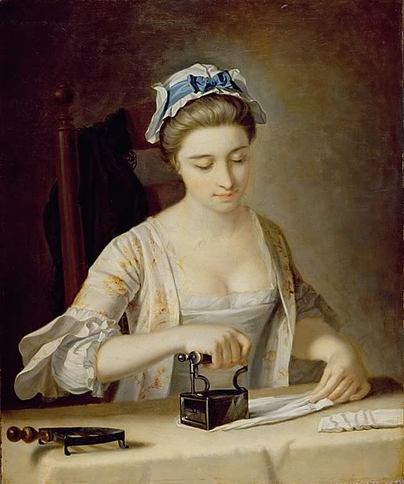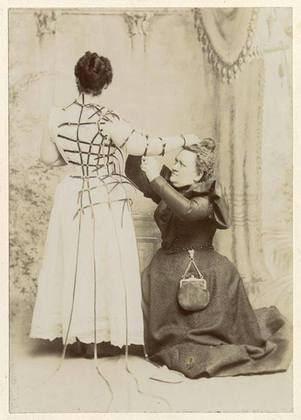|
A client recently made contact with me asking how to care for her gloves! Here is the definitive answer
Easy way Step 1, buy some baby wipes or gentle hand wipes, the more expensive the better. Put some tissue inside the glove under the marks and very gently use the wipe to melt away the dirt or mark! Don’t rub….. Its magic, I know this works as I have used this on white leather shoes. More difficult way. Step 2, If the dirt is very stubborn. Get two buckets with warm water and spread out a small white towel on a table. Buy some very gentle hand wash. I have a lovely cashmere wash. Put some into bucket. 1. Immerse the gloves and gently swish around don’t rub too hard on any mark. Leave to soak a little. Then when the dirt has gone, shake off the soapy water and transfer to the clean bucket of water to rinse. Again DO NOT SQUEEZE. Then remove and put onto the towel, dab at the excess water and leave to dry flat and away from direct heat. The gloves will have lost some natural oils. Buy some clear leather conditioner, either for shoes or furniture and ideally put the gloves on and gently massage in the conditioner. Hey Presto.. clean gloves!
1 Comment
1. We recommend de-pilling cashmere before washing, then turn the garment inside out and wash by hand in lukewarm water followed by a cold rinse. To remove excess water, gently squeeze in a towel, then dry flat on a clothes horse. If machine washing, use a gentle setting and machine wash cold. A light steam will reshape the garment. If hanging, use one of our curved rubber hangers to help preserve the shape of the garment.
2. You cannot prevent cashmere from bobbling since it is friction during wear that causes this, however de bobbling machines are available to tackle this. You can also de-pill by hand or use a knitwear comb, by gently but firmly gliding the comb across the garment. 3. Cashmere is also known as Pashmina and it comes from Himalayan Mountain goats. The wool is incredibly soft, light, durable and not unlike silk. Cashmere provides superior warmth but without the weight of heavier woollen garments. 4. Store neatly folded cashmere in acid free tissue paper to prevent discolouration and use zipped, breathable storage bags. Popping an anti-moth sachet inside keeps the garments fragrant. 5. Do not wear cashmere too frequently. Allow the garment to rest for a few days and avoid wearing with or next to items that are likely to exacerbate pilling for example velcro, metal costume jewellery, bags or belts. Many people underestimate how important hangers are in keeping your clothes perfect. If you have clothes you love, be aware that using incorrect hangers can cause your clothes to mark or become pulled out of shape.
TROUSERS
JACKETS AND COATS
SKIRTS
DRESSES
TIPS
As the weather warms up, thoughts turn to packing away our winter wardrobe - but how best to store our much-loved cashmere and keep the munching moths away? BY BIBBY SOWRAY | 07 MARCH 2014 This weekend, much of the Britain will enjoy unseasonably warm temperatures. As such, we're starting to think about packing away our winter warmers and bringing our spring-appropriate pieces out of hibernation.
A relatively thought-free task, you may think. But it's not - not when cashmere is in the packing-away equation. If you want your favourite jumper to be in tip-top condition when you reacquaint yourself with it next autumn, you need to ensure that you're giving your cashmere the required TLC when it comes to preparing it for storage and packing it away. Washing If, like us, you avoid washing your cashmere wherever possible - i.e. spot-cleaning instead - now is the time to change. Before you send it to the drawer of sleeping clothes, it's best to give it a thorough cleanse. Even if it doesn't look dirty, the tiniest traces of food, skin and hair particles or sweat can still attract clothes moths. Stating the obvious, cashmere needs to be washed by hand - unless you have a hand-wash setting on your machine or don't mind forking out for dry cleaning (moths hate the smell of dry-celaning fluid so this, if you want to spend the money, is a good option before storage). If you're going down the DIY route then there are some simple steps to follow: · Wash in a clean sink, ensuring there is no food or cleaning product residue that could stain/harm your cashmere. The best way is to use a brand new plastic wash basin or even a large, clean mixing bowl. · Make sure the water is no hotter than lukewarm. · Use a small amount of gentle detergent, whether it's one specially-made for cashmere (find our all-natural favourite here) or even a very gentle baby shampoo, and ensure it's fully dissolved in the water before you begin washing. Julia Dee, founder of storage and clothing care emporium totalwardrobecare.co.uk andthewardrobecurator.co.uk, even suggests following with your hair conditioner to make your cashmere super soft. · Turn inside out. Don't rub, wring or twist the fabric while washing, instead just gently squeeze the water through the fibre. · When rinsing, use the same temperature water as you used to wash. Drying The same goes for drying: be gentle, and definitely do not tumble dry: · Don't wring or twist to remove excess water, instead lay the item out on a towel, gently roll up (like a sausage roll) and lightly press. Unroll and reshape by hand. · Leave it to dry laid flat - if you hang it, the weight of the water will stretch it out of shape. · Keep it away from heat sources like radiators and sunlight, allowing it to air-dry naturally. Quality control Before you pack away, give your cashmere an MOT. De-pill and de-crease so that when next winter comes, it looks as good as new. It's likely that any well-worn item of cashmere will have fallen victim to pilling. This "is not symptomatic of inferior quality, but rather an inevitable consequence of the careful processing of this fine fibre," says Rosie Sugden, creator of her own eponymous line of cashmere accessories. Said pilling can easily be removed using de-bobbling comb - like this one - or even a standard razor, though you need to be verycareful not to cut the fabric if doing so. "You will find that, removing the pills in this way, the garment will actually consolidate and soften in handle and touch. Like fine wine, cashmere will improve with age if cared for properly, and will last for years," adds Sugden. To de-crease, iron inside-out on the lowest heat setting using a damp cloth between the cashmere and the iron, keeping it moving. Or, if you can, steam it using a hand-held steamer. Julia Dee has some more handy tips for keeping your cashmere looking fresh. "Don't wear the same garment too frequently," she advises. "Allow it two or three days rest after a day of wearing." Similarly, you should be mindful about what you wear your cashmere with. "A cashmere garment next to rough clothing, metal necklaces, bracelets, belts and rough leather items such as crocodile leather bags is a recipe for pilling and snagging," she says. Storage Here is Julia's expert advice for cashmere storage perfection: 1. Do some house keeping. Any storage area - whether it's a cupboard, under the bed, top of the wardrobe - needs to be hoovered, dusted and wiped down first, to ensure it's completely clean and damp-free. 2. Declare war on moths. If your chosen storage place is a shelf or drawer, line it with fragranced anti-moth paper. If it's a wardrobe, invest in some cedar balls or scented sachets - there are a whole load of options here - to keep the creepies at bay. I'd also recommend popping one or two sachets amongst your knits - and don't forget to replace any old ones, they loose their strength after a season. 3. Do not use cardboard boxes to store your cashmere in - they are not pH neutral so the chemicals in the fabric could react with the acid or alkaline in the boxes (brown cardboard boxes are very alkaline). We have a great breathable bag that is 10cm deep and can store around five knits. It has a breathable top and bottom and has a clear plastic wide band so you can see what's inside. And it's moth proof! 4. Similarly, don't leave garments in plastic bags for more than three months because of the change in temperature - central heating going on and off causes condensation in the bags, which dries on the garments and can cause mildew or yellowing on light colours. 5. If you can, wrap your cashmere in acid-free tissue paper, which preserves original colour and protects against damp and dust. 6. As a general rule, any stored clothes need to be kept well-aired, dust free and covered, away from sunlight. Nothing should be left in direct sunlight as sunlight rots fabrics. If you already have moths… "You really need to do the big clear out," says Julia. "We recommend a moth trap in every room as a good way to monitor if you have a problem - it's a sticky pheromone trap that kills the male moths and leaves the females flying around with no eggs to lay." Another tip is to freeze you cashmere. "This may sound to be a strange route but has been proven to work," says Rosie Sugden. "Simply put them in a plastic bag and freeze for a day or overnight. Then defrost them slowly and this should kill anything, including moths and moth larvae." "The lifecycle of a moth is about 21 days," adds Sugden, "so every month it is a good idea to give your cashmere a good shake out. The moths hate being disturbed and don't like the light, so if you suspect that you have moths it may also be a good idea to air your garments briefly in day-light as the larvae are repelled by this and will drop off your clothing if there are any." Full Article: http://fashion.telegraph.co.uk/columns/bibby-sowray/TMG10681063/How-to-care-for-and-store-your-cashmere.html When the concept for Total Wardrobe Care was created, the owner Julia Dee couldn’t find all the products she needed and has spent the last five years researching and developing the best products for hanging, storing and protecting clothing in wardrobes.
Her biggest challenge was to find a natural moth deterrent that did not leave a nasty smell on clothes. She researched and compiled a list of repelling herbs and gave it to a perfumer in the New Forest who created a fragrance that we like and moths hate! The blend of ingredients to protect your clothes from moths and to have a nice smell within your wardrobe was born! May Chang, Lavender, Cedarwood, Patchouli, Laurel, Rosemary, Clove and Thyme. Hannah Jackson-Matombe looks at how cleaning has changed over the past century Like many, I found myself in need of a cleaner while exhausted by pregnancy, and even more so when four children left me overwhelmed with mountains of washing and scribbled walls. But somehow, even with a cleaner the house was never really clean. It was partly my fault for thinking that one cleaner could keep my modest but over-stuffed home genuinely clean as well as neat and tidy with just six hours of cleaning a week. We found ourselves living with serious infestations of both food and clothes moths. And despite requests to limit their use, the quantity of toxic products used was leaving my children with skin rashes and blocked noses and me feeling seriously ill. It seemed rather a radical solution, but I gave up my profession as a …. and started doing the cleaning myself. I also did some research. I found for example that in 2010 the American internet journal Environmental Health reported that use of air fresheners and products for mould and mildew control were associated with increased risk of breast cancer. This report along with many others can be found at www.sciencedaily.com. I also realized that modern cleaning products are designed to do little more than limit bacteria and while the words "green", "organic" and "natural" are often used to describe them, but some of the ingredients are far from safe. It seems I was not alone in my problems. With more women working full time and so doing less cleaning, and houses with sealed windows, central heating and less space, seems to have led to a massive increase in asthma, eczema and hives, even it seems fertility problems. And there are certainly more moths, carpet beetles, bed bugs and more. These pests flourish in places left undisturbed by day to day cleaning, leaving them to flourish and ravage your furnishing and clothes. I started looking into more sustainable and traditional cleaning techniques, moth removal, bed bugs, dust mites and carpet beetles. And then I realized what I was really doing was returning to my roots. My nan was a professional housekeeper, her cleaning and household management skills so good that when he was widowed, her employer married her. Granny Beeton, as she was called by myself and my sisters, was an expert in household management who accorded cleaning a status it doesn’t get today and she would have given short shrift to most current cleaning ladies who do a few dishes and run the vacuum round the middle of the floor. Granny Beeton said that in the 18th- 19th century households in London had at least three or more cleaning staff, headed by the housekeeper. Pay would have been low and the employers rich, but this was not about keeping up appearances, it was about quality of life and health. She reported how staff would take furniture on to the street to make use of the effective deterrents of sunlight and fresh air, rugs would be beaten with brooms over washing lines, and the interiors or every room would be cleaned inside and out, including every last corner of wardrobes and drawers which were not stuffed overfull. Scented drawer liners and sachets of Lavender or Cedarwood kept the likes of moths and bed bugs at bay.
Kitchen benches and cupboards were scrubbed inside and out, removing built-up grease. Utensils were scrubbed and polished, light fittings were cleaned in minute detail, and the ovens were scrubbed with lemon oil. Household dust, which is largely made up of human skin and hair, was carefully removed, reducing sustenance for moths, dust mites and more. Even in the middle of the 20th century the deep clean was still popular among both middle and working classes, often with family members and friends helping each other. My mum was a very modern lady selling Tupperware part-time, but she and her siblings, headed by Granny Beeton, would organise deep cleans in each others’ homes. An added benefit of these sessions was that the mums were always completely on top of what the family had or needed - unlike me who recently discovered my four boys had around 50 pair of trousers between them, but very few t-shirts and no pants! As I researched I realized my daily cleaning wasn't what was required. It needed not just time, but also a team and a system. I roped in a few reluctant individuals to provide a deep clean of my kitchen and what took me more than a day on my own, took three people just four hours. And the results were amazing; we cleared the moth infestation and to ensure no further infestations I put phermone stickers in the cupboards to catch male moths and stop them breeding. Find out more www.spotlessorganic.com/ Well, if everyone mended and altered we wouldn’t be here – most people don’t have the time or the resources. Here are a few tips:
 Go Through Your Wardrobe - Make-Do and Mend, c.1942. The Ministry of Information launched a campaign, Make-Do and Mend, to help people deal with clothes rationing. Posters and leaflets encouraged women to repair and renovate their old clothes, and offered helpful suggestions for how to create new outfits for themselves and their children from worn-out clothes and scraps of fabric.
|
The Wardrobe CuratorAll the latest news, tips and advice from Julia Dee. Archives
October 2018
Categories |
|
"My jumpers arrived back on Friday, only 8 days after I posted them to you and I am delighted with the results- I cannot even find the repair on two of them - amazing ! Thank you and your team so much for such a fantastic service!"
Wonderful feedback from one of our customers!! |






















